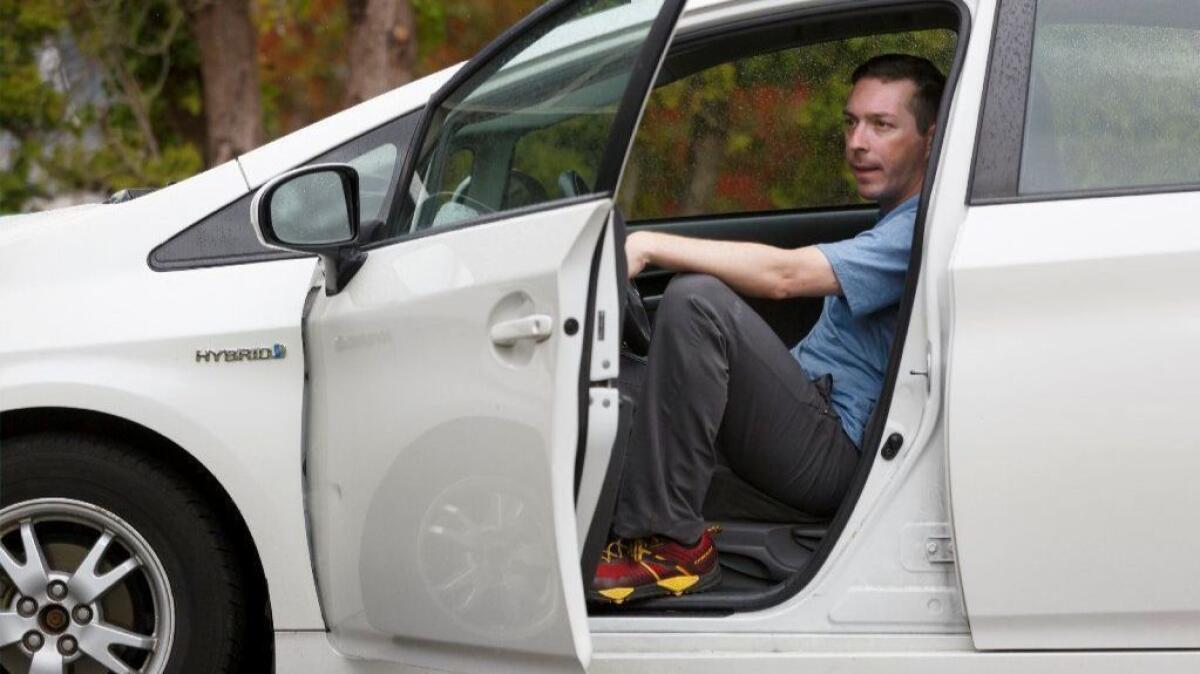After second recall, Toyota Prius electrical system is still overheating

Jordan Felo had just finished hiking in the local mountains outside Portland, Ore., several weeks ago and was headed home in his 2010 Toyota Prius when it suddenly lost power and slowed to a crawl.
Felo had taken the Prius to a Toyota dealer a few weeks earlier for a 2018 safety recall. New software was installed to fix an overheating problem in the electrical power system. Yet when Felo hit the accelerator pedal, a key electronic component called an inverter overheated and fried itself.
For the record:
7:25 a.m. April 14, 2019An earlier version of this story misspelled David Carmen’s name as Carman. In addition, Skip Miller was incorrectly identified as Skip Lewis.
“I was lucky nobody was behind me because I would have been rear-ended,” recalled Felo, a salesman at an REI retail store. The car was towed to the dealer, which gave Felo the bad news: It would cost $3,000 to replace the shoe-box-sized unit.
Felo’s experience and others like it are raising questions about the adequacy of Toyota’s attempts over the last five years to stop overheating in the Prius electrical system, and why the National Highway Traffic Safety Administration hasn’t taken stronger regulatory action.
Originally, Toyota issued a safety recall in 2014 to address the inverter defect in model years 2010 to 2014, an attempt to fix the problem on about 800,000 cars in the U.S. by modifying software that controls the hybrid electrical system.
By 2017, it was clear the software modification was not working.
One of Toyota’s largest dealers in Southern California, Roger Hogan, told the manufacturer in 2017 that he was seeing inverter failures on vehicles that had received the software modification. At the time, he was refusing to resell about 100 used Priuses that he had taken on trade-in, asserting he did not believe they were safe. Hogan filed a defect petition with the NHTSA in December 2017, asking for a safety investigation, and filed a lawsuit against Toyota that alleged the recall was a sham. A trial in Orange County Superior Court is set for next month.
Those events led to a second recall in October 2018. But it turns out that action wasn’t aimed at fixing the inverters — which are still getting fried, according to Prius owners whom The Times contacted and who brought vehicles to Hogan’s garages.
Theo Bare of Elmhurst, Ill., for example, said he had the 2018 software update performed on his 2010 Prius in February and then three weeks later saw the hybrid warning light come on.
Full coverage: Toyota Prius defects and recalls »
Hogan contends that the only genuine remedy to the overheating problem would require installing newly designed inverters — a step that could cost more than $2,000 per vehicle.
The inverter uses high-power transistors to boost the 200 volts from the Prius battery to about 500 volts, and converts electricity from direct current to alternating current. The process is reversed when the brakes are applied and the battery is charged.
In a statement, Toyota said it remains “committed to the safety and security of our customers” and rejects Hogan’s allegations. “We monitor the available information on this issue and would continue to investigate any new information that emerges and take any appropriate action,” the statement said.
The Prius is designed so that if the inverter fails, the car enters a fail-safe mode, known as limp-home, in which it can move slowly out of traffic to “enhance safety,” the company statement said. The 2018 recall was aimed at fixing the vehicle’s potential failure to enter limp-home, the company said in both its statement and a regulatory filing.
That position appears to be a change from 2014, when the recall aimed to both fix the inverter overheating and to ensure the vehicle could move out of traffic. According to a federal defect information report that the company filed at the time, the software “will prevent damage to the [inverter transistors] and also prevent a hybrid system shutdown.”
The company, however, said in its recent statement that inverter failure is not a safety defect by itself. Thus, if inverters are failing after the second software update, that is not a shortcoming of the recall. It described fail-safe mode as “common in the auto industry.”
Jason Levine, executive director of the Center for Auto Safety, said limp-home is better than complete power loss, but it reduces a car to a “large golf cart.” There are few, if any, federal safety regulations that govern limp-home, he noted.
More than a dozen Prius owners who experienced inverter failure told The Times in interviews that they were terrified by the experience.
In one case, a Marina del Rey woman had to cross three lanes of fast-moving traffic on the 91 Freeway. In another case, a Florida woman was rear-ended. The crash left her with a cracked vertebra and a punctured lung, she said.
Even though Toyota says defective inverters are safe as long as they enter limp-home, it has extended the warranty on 2010 to 2014 models. Owners with failed inverters can get a free replacement for up to 15 years with no mileage limit.
In its defect information report filed with NHTSA on Oct. 4, Toyota described the warranty as intended “to support increased customer satisfaction” and described it as a “separate program” from the recall.
Hogan, however, contends Toyota is trying avoid a multibillion-dollar replacement program for the defective inverters.
“Unfortunately, there’s been a trend of manufacturers trying to turn safety recalls into what sound like performance-related technical bulletins,” Levine said. “It’s deceptive and it’s dangerous.”
Even though Hogan petitioned the NHTSA for a defect investigation in December 2017, the agency never initiated a formal process.
Instead, NHTSA officials held a series of six closed-door meetings with Toyota officials prior to the October recall, according to David Carmen, a government affairs consultant who is part of Hogan’s legal team. Hogan had his own meeting with the NHTSA in June 2018, in which he gave investigators a charred inverter from a Prius that had failed after getting the original software update.
By October, Toyota itself acknowledged that the original recall could not ensure the safety of the vehicle.
The NHTSA’s chief counsel, Jonathan Morrison, told Carmen in a meeting last month that it was Hogan’s complaint and the evidence of a charred inverter that prompted the new recall. Morrison did not return calls seeking comment. The Times submitted a series of written questions to NHTSA public affairs officials, but they did not provide answers after several days.
The process the NHTSA followed is part of a trend over the last several years, in which the safety agency does not convene a formal process and instead “conducts business behind closed doors and then pops out an announcement with the manufacturer,” said Levine, the Center for Auto Safety chief.
“Failing to be transparent in the process raises substantial questions about how decisions were made, how much investigation went on and whether NHTSA rubber-stamped a proposal,” he said.
The NHTSA declined to say why it did not open a formal inquiry, but said that it “takes this issue seriously, and although the agency has not opened a formal investigation at this time, NHTSA is continuing to monitor complaints and other sources of information to determine whether there is further risk to the public, and whether additional steps are necessary.”
Not long after the second recall began in December, Priuses with the new software began showing up at Hogan’s dealership stores in San Juan Capistrano and Claremont with hybrid-system problems. And the failures continue to crop up all over the country.

Dennis Benedetto of Durango, Colo., was driving home on March 28 with his wife and baby when his 2010 Prius’ warning lights flashed on his dashboard indicating the electrical system was overheating, he said in an interview. The car went into limp-home mode.
He pulled over and his wife, Monica, walked home carrying the baby. He bought the vehicle in January and had it inspected by the local Toyota dealer, who performed the software update, he said.
“It looked like something was smoking,” he recalled. Benedetto said he hasn’t driven the car since.
Bare, who recently left school with a master’s degree in computer science, said he could still drive his Prius after it overheated. It has since overheated a second time, but he was again able to keep driving it after it cooled.
Hogan said he continues to refuse to sell the recalled Priuses that he takes on trade-in. He now has 120 parked on his dealership lots. That stance has gotten him in trouble with Toyota.
“They said you have become an enemy of Toyota and that you clearly don’t want to be in the Toyota family,” said Hogan. He describes himself and his family-run operation as longtime Toyota loyalists. Nonetheless, Toyota is cutting deliveries to him of its most popular models, claiming he is not meeting his sales quotas and failing to make warranty inspections for his customers, he said.
“These are retaliatory hardball tactics,” said Skip Miller, Hogan’s Century City attorney, who is representing him in the civil suit against Toyota that alleges breach of contract and fraud.
Hogan has also sought whistleblower protection under a provision of a 2015 federal transportation act. The petition for whistleblower status was submitted this year and accepted by the Transportation Department, Miller said. The NHTSA provided no details, but it said it “will ensure that due consideration is given to whistleblower submissions and to any other relevant sources bearing upon the issues involved here.”
Toyota has taken a tough stance with Hogan, saying: “Mr. Hogan is pursuing his Prius recall remedy allegations to advance his lawsuit against Toyota for $100 million.” Previously, Toyota said Hogan is seeking to “blame Toyota for his son’s failure to meet basic qualifications to serve as a general manager at one of his dealerships.”
Toyota’s 2018 recall differs not only from its 2014 recall, but also from its approach in the recall of its 2006 to 2010 Highlander hybrids, which also had an inverter overheating problem. Toyota replaced a part, known as the intelligent power module, which holds the transistors in the inverter.
Philip Barton, an attorney in Vancouver, Canada, said his 2010 Highlander hybrid system failed after the intelligent power module had been replaced in 2013. A Toyota dealer quoted him 12,000 Canadian dollars — $9,000 — to fix the vehicle. Barton declined and instead bought a Subaru.
“The Highlander is gathering dust at the dealership,” he said. “I am taking Toyota to small claims court. We will argue it had a latent defect when we bought it in 2010.”
Twitter: @rvartabedian
More to Read
Start your day right
Sign up for Essential California for news, features and recommendations from the L.A. Times and beyond in your inbox six days a week.
You may occasionally receive promotional content from the Los Angeles Times.







